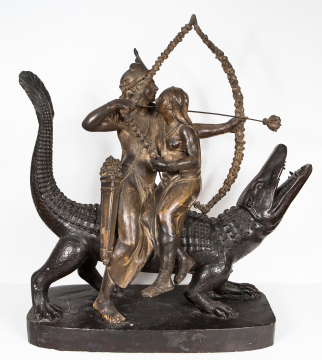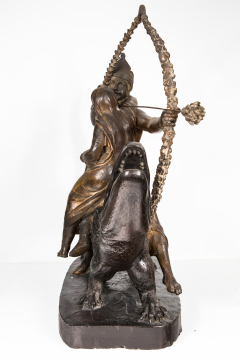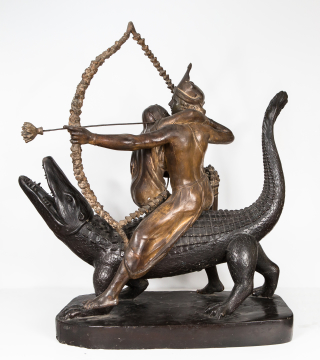Explore Collections


You are here:
CollectionsOnline
/
The Hindu Deity Camadeva with his mistress on a crocodile
Browse
Sculpture, 'The Hindu Deity Camadeva with his mistress on a crocodile'. SM A12. ©Sir John Soane's Museum, London. Photo: Lewis Bush
Thomas Banks RA (1735 - 1805), sculptor
The Hindu Deity Camadeva with his mistress on a crocodile
c.1794
Painted plaster
Height: 61cm
Width: 63.5cm
Width: 63.5cm
Museum number: A12
Not on display
Curatorial note
Kamadeva or Kama ('Camadeva' was the spelling used in Soane's time), the Hindu god of earthly love, prepares to fire one of his flower-tipped arrows of desire from his sugarcane bow, strung with honey bees, as his wife Rati (passion) advises him on his choice of target. An alternative interpretation is that female figure is the embodiment of Vasanta, or spring (the festival of Kama is Holi, which marks the coming of Spring). Kamadeva is usually shown riding a peacock or parrot and Banks may have chosen a crocodile as a more sculptural support.
The title of the sculpture is taken from the catalogue of Banks’s studio sale of 1805 (lots 66, 67, 68) which records, in plaster, the mould and a cast. The items in the sale may not have included this plaster version for it is referred to in 1830 by Soane in a way that implies it was a gift from the sculptor: ‘For the beautiful Model of a dying Patriot, and the cast of the Creshna [Krishna] of the Indians, I am indebted to my esteemed friend the late Thomas Banks, R. A.’.1 The sculpture is shown in a sketch of c.1822-5 on top of the bookcases on the East side of Soane’s Library.2 By 1826 it was on display in a prominent position in the 'Lobby to the Breakfast Room' which Soane created in c.1824-25 on the ground floor of his Museum (restored 2016) and the sculpture can now be seen again in that position.
The origins of this group are suggested by the lotting up of it by Christie’s in 1805 with models for two chimneypieces for Warren Hastings that had been exhibited at the Royal Academy in 1792 (cats. 46, 47). The chimneypieces had been designed with Indian atttributes for Daylesford, Hastings' estate in Gloucestershire. The former Governor General of Bengal might have suggested the subject of this sculpture to Banks with a view to its reproduction for the Indian market.
A loose sketch of the same composition by the sculptor John Flaxman, presumably made from memory in 1794, inscribed by him T. Banks, is pasted in a sketchbook and album used by Flaxman in Rome between 1787 and 1794 (John Murray Collection).
1 Soane, Description, 1830 p.3.
2 SM Vol. 82, 5. The sheet is watermarked 1822 but most of the drawings in the Volume are dated 1825.
This note is based on the entry written by Dr Julius Bryant, with the assistance of Helen Dorey, Deputy Director of Sir John Soane's Museum, for the exhibition Thomas Banks: Britain's first modern sculptor, Sir John Soane's Museum, 2005.
The title of the sculpture is taken from the catalogue of Banks’s studio sale of 1805 (lots 66, 67, 68) which records, in plaster, the mould and a cast. The items in the sale may not have included this plaster version for it is referred to in 1830 by Soane in a way that implies it was a gift from the sculptor: ‘For the beautiful Model of a dying Patriot, and the cast of the Creshna [Krishna] of the Indians, I am indebted to my esteemed friend the late Thomas Banks, R. A.’.1 The sculpture is shown in a sketch of c.1822-5 on top of the bookcases on the East side of Soane’s Library.2 By 1826 it was on display in a prominent position in the 'Lobby to the Breakfast Room' which Soane created in c.1824-25 on the ground floor of his Museum (restored 2016) and the sculpture can now be seen again in that position.
The origins of this group are suggested by the lotting up of it by Christie’s in 1805 with models for two chimneypieces for Warren Hastings that had been exhibited at the Royal Academy in 1792 (cats. 46, 47). The chimneypieces had been designed with Indian atttributes for Daylesford, Hastings' estate in Gloucestershire. The former Governor General of Bengal might have suggested the subject of this sculpture to Banks with a view to its reproduction for the Indian market.
A loose sketch of the same composition by the sculptor John Flaxman, presumably made from memory in 1794, inscribed by him T. Banks, is pasted in a sketchbook and album used by Flaxman in Rome between 1787 and 1794 (John Murray Collection).
1 Soane, Description, 1830 p.3.
2 SM Vol. 82, 5. The sheet is watermarked 1822 but most of the drawings in the Volume are dated 1825.
This note is based on the entry written by Dr Julius Bryant, with the assistance of Helen Dorey, Deputy Director of Sir John Soane's Museum, for the exhibition Thomas Banks: Britain's first modern sculptor, Sir John Soane's Museum, 2005.
Literature
Soane, Description, 1830 p.3
Soane, Description, 1835 p.
Julius Bryant, Thomas Banks: Britain First Modern Sculptor (London, Sir John Soane's Museum, 2005), pp.45-6.
Sarah Monks, 'Making Love: Thomas Banks' Camadeva and the Discourses of British India c.1790' in Visual Culture in Britain, 11:2, 2010, pp.195-218
Soane, Description, 1835 p.
Julius Bryant, Thomas Banks: Britain First Modern Sculptor (London, Sir John Soane's Museum, 2005), pp.45-6.
Sarah Monks, 'Making Love: Thomas Banks' Camadeva and the Discourses of British India c.1790' in Visual Culture in Britain, 11:2, 2010, pp.195-218
Exhibition history
Thomas Banks 1735-1805: Britain's First Modern Sculptor, Sir John Soane's Museum, London, 21 January - 9 April 2005
Soane collections online is being continually updated. If you wish to find out more or if you have any further information about this object please contact us: worksofart@soane.org.uk








